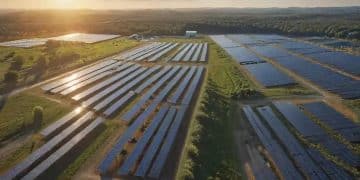Economic impact of agricultural policy changes: what to expect

The economic impact of agricultural policy changes significantly affects farmers by influencing their incomes, investment decisions, and the overall vitality of rural communities, ultimately shaping global agricultural practices.
The economic impact of agricultural policy changes can ripple through communities, reshaping livelihoods and altering farming practices. Have you ever wondered how these shifts affect not just farmers, but the entire food supply chain? In this article, we’ll explore the various dimensions of these policy changes and their potential outcomes.
Understanding agricultural policy changes
Understanding agricultural policy changes is essential for grasping how they influence farmers and the broader economy. These changes can take many forms, impacting everything from crop production to market prices. By analyzing various elements of these policies, we can better predict their potential outcomes.
Key Components of Agricultural Policies
Agricultural policies often include regulations, subsidies, and programs designed to support farmers. These elements work together to create a stable environment for agriculture. Here are some significant components:
- Subsidies: Financial assistance provided to farmers to help reduce their costs.
- Trade agreements: Policies that determine how agricultural products are exchanged internationally.
- Environmental regulations: Rules aimed at protecting the environment while promoting sustainable farming practices.
- Research funding: Government investments in agricultural research to improve crop yields and farming techniques.
As we look deeper, it becomes clear that understanding these components helps us see their direct impact on farmers’ decisions. For instance, when subsidies increase, farmers may be more likely to invest in new equipment or techniques. This investment can lead to enhanced productivity and better quality crops, which benefits consumers as well.
Real-World Examples of Policy Changes
Many countries have experienced significant shifts in their agricultural policies. These changes often lead to varied outcomes based on the local context. For example, a country that reduces tariffs on imported food may see an increase in imports, affecting local farmers’ market share. Conversely, a new subsidy program aimed at organic farming can stimulate growth in that sector.
In many cases, the results of these changes are complex. While they can benefit some stakeholders, others might experience negative impacts. It’s crucial to carefully evaluate how policies are crafted to balance these effects effectively. Farmers’ livelihoods depend on it, and storing the right information is vital for everyone in the agricultural sector.
Understanding agricultural policy changes is not just about the policies themselves but involves tracing their effects throughout the economy. This extends to food prices, rural development, and overall economic stability. As such, active engagement in discussions about agricultural policies is essential for all stakeholders involved.
Key economic effects on farmers

The key economic effects on farmers arise significantly from changes in agricultural policies. These effects can alter how farmers manage their operations and evaluate their prospects. Understanding these economic variables helps farmers make informed decisions that impact their bottom line.
Price Fluctuations
One major effect is the fluctuation of crop prices. When policies shift, the supply and demand dynamics in the market can change. For farmers, this might mean:
- Increased uncertainty: Farmers may face challenges in predicting future income based on price instability.
- Market access: New policies may open or restrict access to markets, further affecting prices.
- Profit margins: Price changes can directly impact profit margins, leading to financial stress or growth opportunities.
These fluctuations force farmers to adapt quickly, either by changing what they grow or how they market their products. Knowledge of market trends becomes vital in these situations.
Investment Decisions
Changes in agricultural policies can also influence farmers’ investment decisions. When subsidies or support programs are implemented, it encourages farmers to invest in new technologies or expand their operations. However, cuts in funding can have the opposite effect.
Farmers may find themselves reassessing the sustainability of their current practices. They might consider:
- Adopting technology: Investing in modern farming equipment can improve efficiency.
- Crop diversification: Exploring new crops can reduce reliance on a single market.
- Environmental practices: Implementing sustainable methods can lead to eligibility for certain grants and incentives.
Such considerations vary based on the policies in place and the specific goals of each farm. These economic decisions play a crucial role in the long-term viability of farming operations.
It’s essential for farmers to be aware of the key economic effects posed by agricultural policy changes. This awareness allows them to navigate financial uncertainties and leverage opportunities for growth effectively. As policies evolve, so must farmers’ strategies to remain resilient in a competitive environment.
Long-term consequences for rural communities
The long-term consequences for rural communities due to agricultural policy changes can be profound and far-reaching. These policies can shape the economic landscape, influence community dynamics, and affect the overall quality of life in rural areas.
Economic Shifts
One critical consequence is the economic shift within the community. As agricultural policies evolve, they directly impact farmers’ income, which in turn affects local businesses. When farmers thrive, they tend to spend more on goods and services, boosting the rural economy. However, if policies lead to decreased incomes, local businesses may struggle.
- Job loss: Reduced agricultural income can result in layoffs and employment instability.
- Business closures: Local shops and service providers might not survive if farmers have less to spend.
- Population decline: Economic hardships can push families to seek opportunities in urban areas, leading to depopulation.
This cycle can create long-lasting challenges for rural communities, emphasizing the need for robust support systems and policies that prioritize sustainable growth.
Social Impact
The social fabric of rural communities is also affected by these policy changes. Agricultural policies determine the types of crops that are grown, which can influence dietary habits and health outcomes. Access to fresh produce may change, depending on what farmers are incentivized to grow. This shift can impact the community’s overall health.
Furthermore, education and community programs might face funding challenges due to economic constraints. A lack of investment in education can hold back future generations, affecting their prospects:
- Access to education: Schools may struggle with funding, impacting educational quality.
- Health disparities: Changes in agriculture can affect nutritional health and access to fresh food.
- Community engagement: Lower economic stability can reduce participation in local events and programs.
These social aspects showcase how intertwined agricultural policies are with the overall vitality of rural communities, making it crucial to understand their implications.
Being aware of the long-term consequences of agricultural policy changes allows rural communities to advocate for policies that support their growth and resilience. As these policies evolve, so too must the efforts to strengthen community bonds and economic stability.
Global perspectives on agricultural reforms

Global perspectives on agricultural reforms showcase a variety of approaches countries take to enhance their agricultural sectors. Different nations implement reforms based on their unique challenges and opportunities. Understanding these global perspectives can provide insights into best practices and potential pitfalls.
Diverse Approaches to Reform
Countries worldwide face distinct agricultural challenges. For instance, some nations focus on increasing productivity through technology, while others prioritize sustainability and environmental protection. Here are common strategies observed globally:
- Technological integration: Many countries adopt precision farming techniques to maximize yields and reduce waste.
- Subsidy reforms: Adjusting subsidy programs can help redirect funds to support more sustainable farming practices.
- Trade liberalization: Opening markets through trade agreements can enhance competitiveness for local farmers.
- Climate-smart agriculture: Implementing practices that improve resilience against climate change impacts is gaining ground.
Each of these approaches reflects a tailored response to a country’s specific agricultural landscape, and the effectiveness of these strategies varies widely.
Case Studies of Successful Reforms
To better understand the advantages and disadvantages of agricultural reforms, examining successful case studies can be helpful. For example, countries like Brazil have implemented successful policies that boosted agricultural exports significantly. They embraced biotechnology and investment in infrastructure, which strengthened their agricultural output. Similarly, the European Union focuses on strengthening food security while advocating for environmentally friendly practices.
These case studies illustrate how targeted reforms can lead to significant economic growth and enhanced food production. Local contexts play a crucial role in determining the suitability of various strategies.
As we consider global perspectives, it becomes evident that there is no one-size-fits-all solution. However, collaboration and sharing information among countries can foster innovations in agricultural policies. Learning from others’ mistakes and successes supports ongoing improvements in agricultural practices worldwide.
FAQ – Frequently Asked Questions about Agricultural Policy Changes
What are agricultural policy changes?
Agricultural policy changes refer to government actions aimed at managing and influencing agricultural production, income, and trade.
How do policy changes affect farmers?
These changes can impact farmers’ incomes, influence market access, and shape investment decisions in farming practices.
What long-term effects do these policies have on rural communities?
Long-term effects include economic shifts, changes in community engagement, and potential declines in population as families seek better opportunities.
How can countries improve their agricultural policies?
Countries can enhance their policies by adopting best practices from others, investing in technology, and focusing on sustainability for better outcomes.





